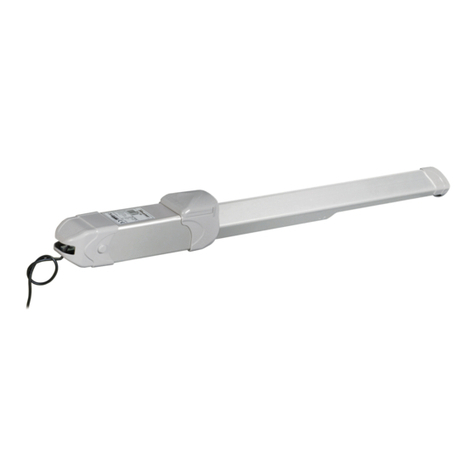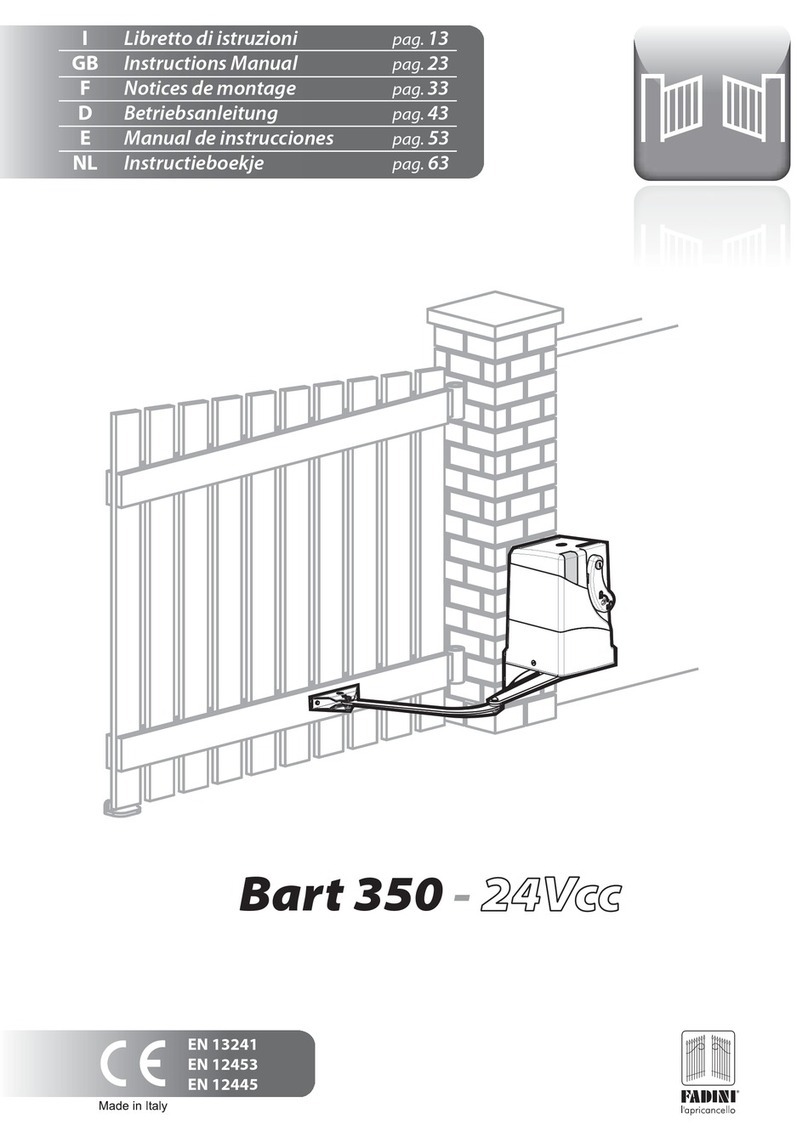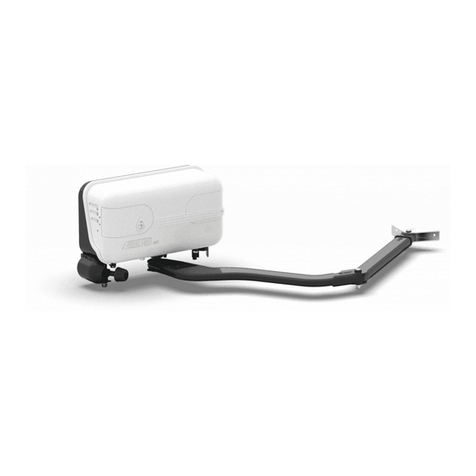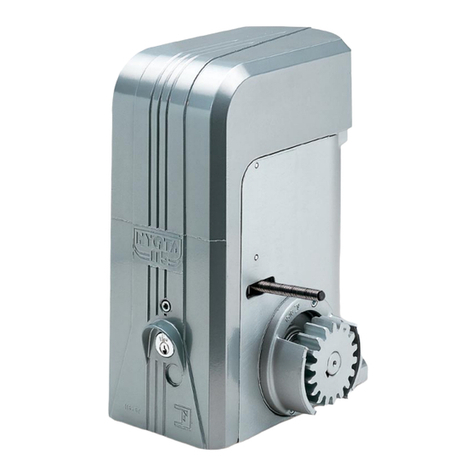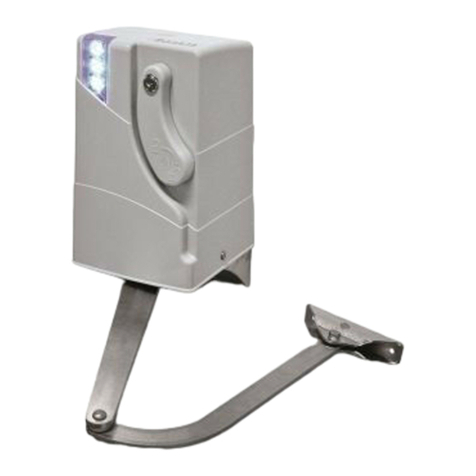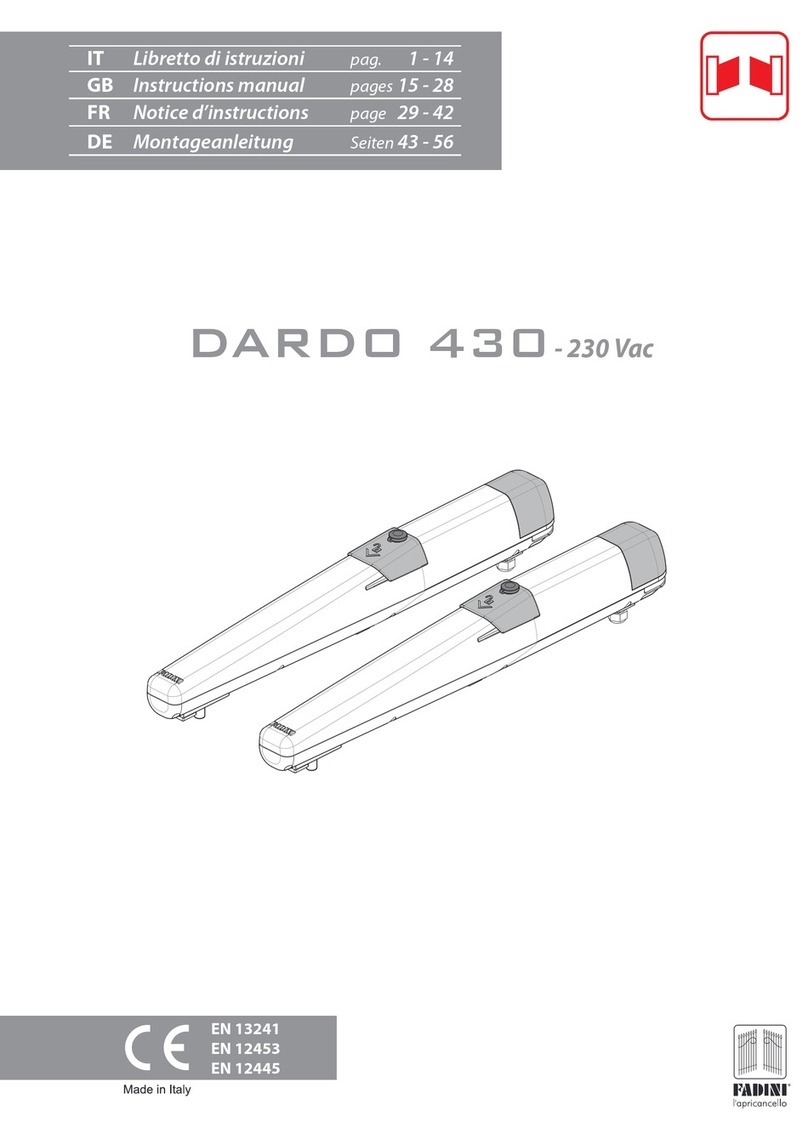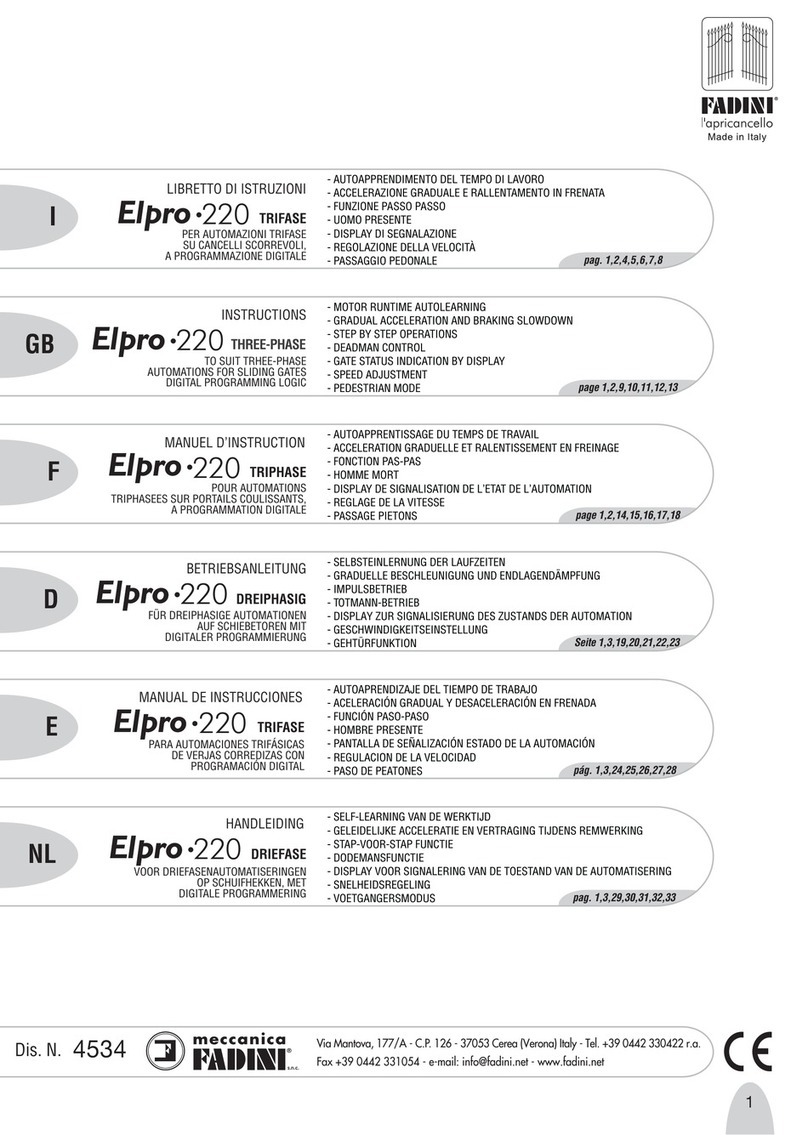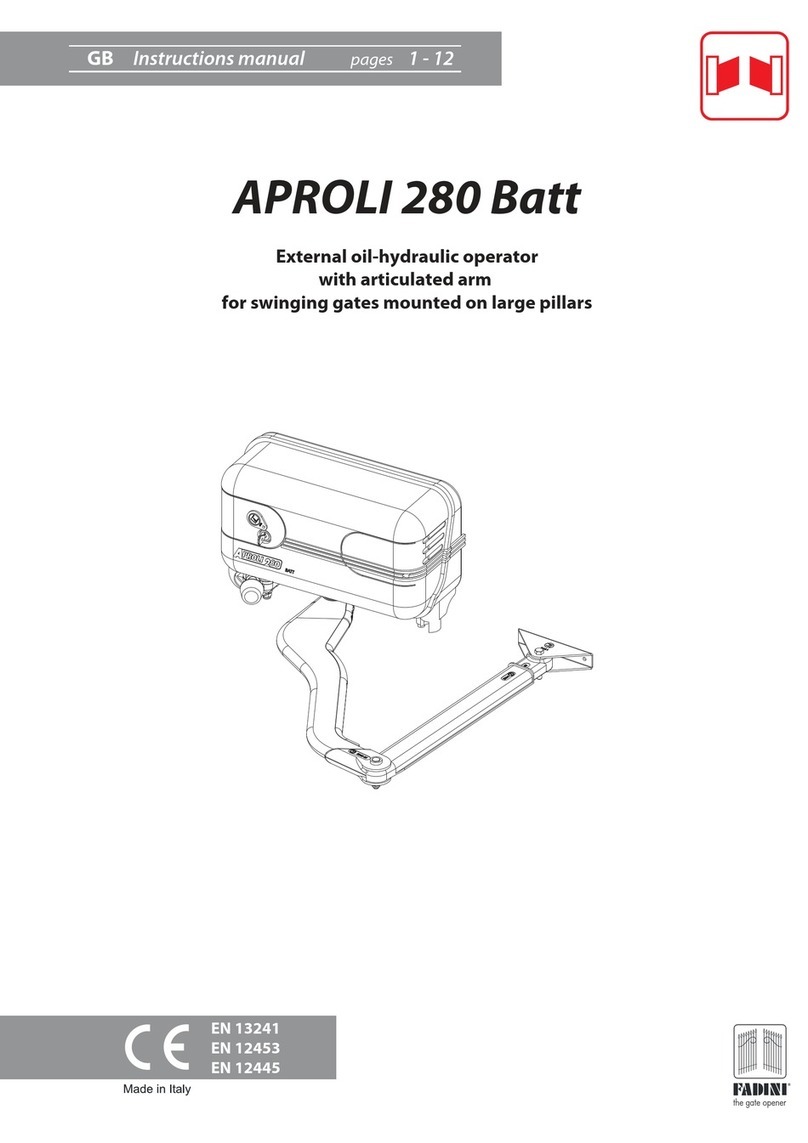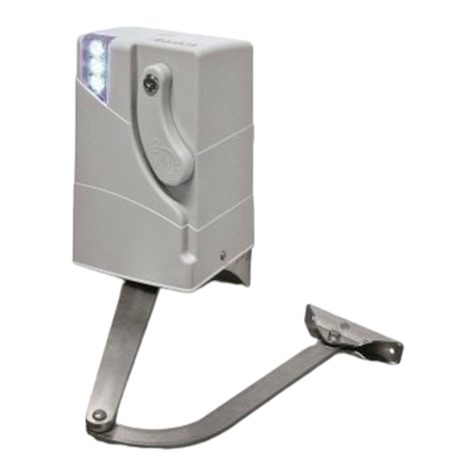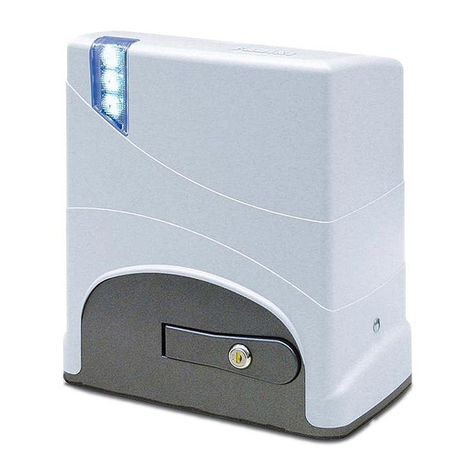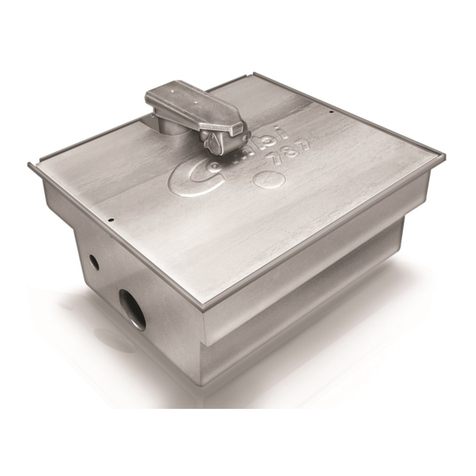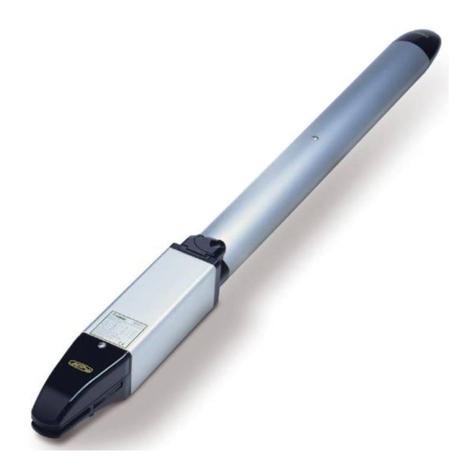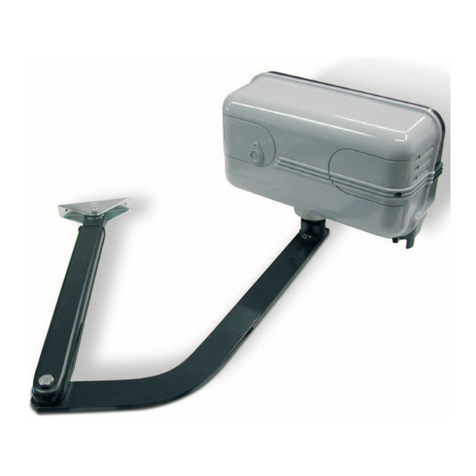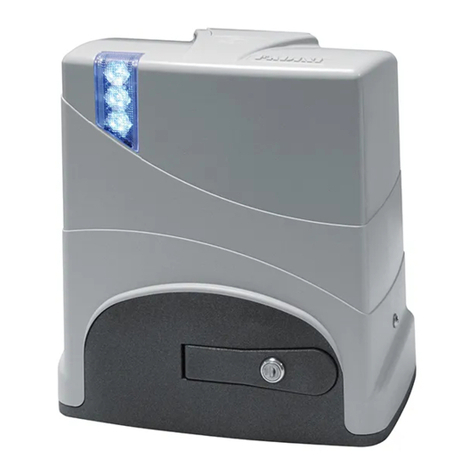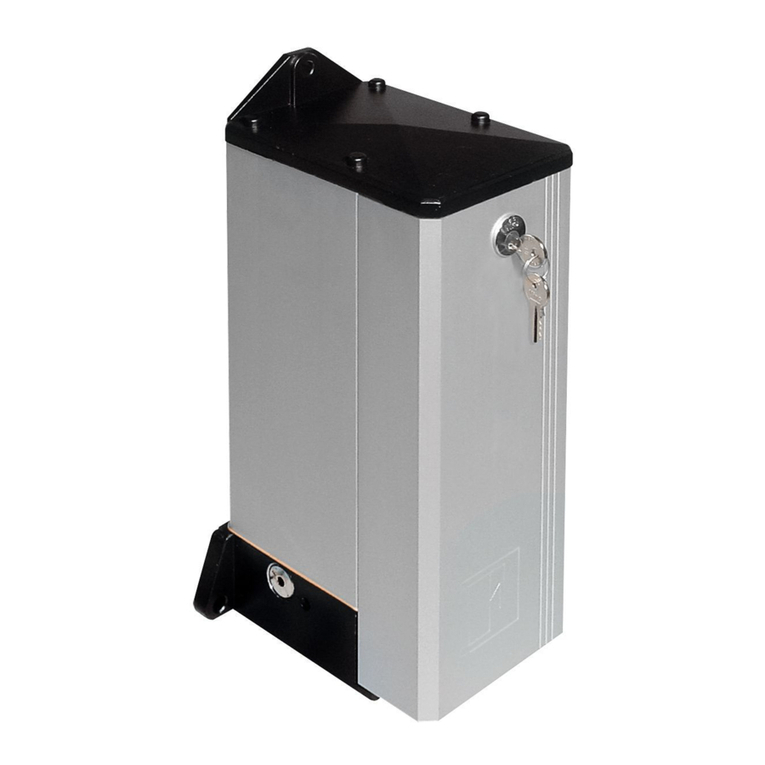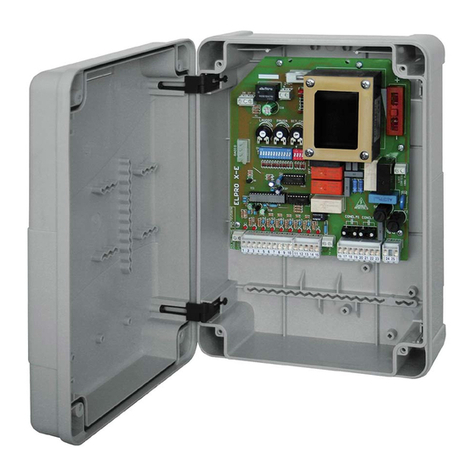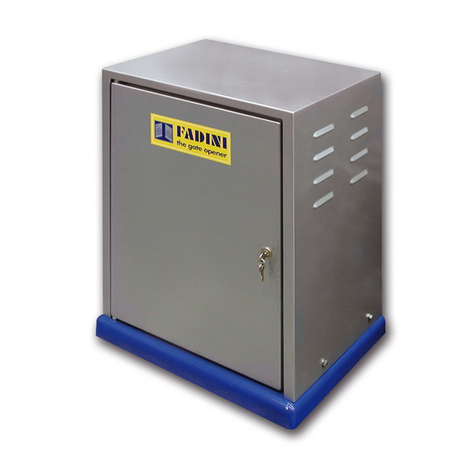
9
8
PIC. 16
- Carry out all the electrical connections to the Elpro 13 CEI control panel
-
First running test: set the Motor Run Time 09 to a value 4-5 seconds higher than the time required by the gates to reach the gate stop;
set the Dwell Time 08 (automatic mode) and Gate Delay Time in Closing Cycle 07 (in case of double swinging gates) as required, pic. 16:
- Automatic Mode: Dip-switch “B” No. 3set to ON. Once an open pulse is given (to terminals 4 and 8 in Elpro 13 CEI main terminal
board, pic.16), the gates are driven to open, stopped for a time as set by the Dwell Time 08 and then automatically re-cycled to close.
- Semi-automatic Mode: Dip-switch “B” No. 3set to OFF. Once an open pulse is given, the gates are automatically operated only to
open; a second pulse (to terminals 5 and 8 in the Elpro 13 CEI main terminal board, pic.16) is needed to close the gates.
- Radio Contact: terminals 7 and 8 in the Elpro 13 CEI main terminal board, pic.16. Any pulse from a keyswitch, remote control or push
button reverses the gate travel (it is recommended to carefully read the instructions provided in the control box).
FEATURES OF THE ELECTRONIC PROGRAMMER FOR SWINGING GATES
All the electrical connections are to be made as per the following instructions and diagrams. Supply the terminals 24-25 with 230V -
50 Hz single phase voltage. The “red LED” switches on and stays on as long as the board is properly supplied. Through the timer No. 9
you can control the running time of the motor in both cycles, OPEN and CLOSE.
Set it so that the running time of the motor is longer than the actual travel of the gate: set the timer No. 8 -DWELL- ie. the interval between
open and re-closing, so that you can meet the required interval of time.
- With the electric motor connected to terminals 19 - 20 - 21: the delay is operative in the “open” cycle, with a factory pre-set time.
- With the electric motor connected to terminals 16 - 17 - 18: the delay is operative in “close” cycle and can be adjusted through the
timer No. 7 on to “less” or “more”.
LOGIC OF THE ELECTRONIC PROGRAMMER: When a pulse is given, the flashing light switches on. After three seconds the motors start.
During the interval before re-closing, the light stays on. When the gates are fully re-closed, the light keeps on flashing for three more
seconds and then switches off automatically.
The 3 second interval (pre-flashing) which precedes the actual start of the motors can be eliminated by means of the DIP-SWITCH “B”
No.4.
LED No. 1: It switches on when voltage is supplied.
LED No. 2: “PHOTOCELLS”. Normally on. It switches off when the photocells are obstructed.
LED No. 3: “OPEN”. It switches on when the respective switch is activated.
LED No. 4: “CLOSE”. It switches on when the respective switch is activated.
LED No. 5: “STOP”. Normally on. It switches off when the respective switch is activated.
LED No. 6: “RADIO”. It switches on whenever a pulse is given, either from remote control, keyswitch or push buttons.
DIP-SWITCH BSETTING IN ELPRO 13 CEI
N°1 OFF = PHOTOCELLS. NO STOP IN OPEN CYCLE. REVERSE/CLOSE
N°2 OFF = REMOTE CONTROL. REVERSE
N°3 OFF = NO AUTOMATIC RECLOSING
N°4 OFF = NO PRE-FLASHING
N°5 OFF = REMOTE CONTROL. NO STOP AND HOLD AS LONG
AS BUTTON DOWN. IT OPENS STRAIGHT AWAY
N°6 OFF = BOTH LEAFS ARE OPERATED
N°7 OFF = STROKE REVERSING PULSE OUT OF SERVICE
N°8 OFF = LEAF DELAY OPEN CYCLE.
ONE STARTS BEFORE THE OTHER
LAMP ON = GATE OPEN
LAMP FLASHES SLOWLY = GATE OPENING
LAMP FLASHES FAST = GATE CLOSING
LAMP OFF = GATE CLOSED
1) It is advisable not to expose the control box directly to weather conditions; if mounted outside, a suitable enclosure is recommended
to protect it from sunshine and rain.
2) Bridge terminals 1 - 2 if you do not require any photocells.
3) Should two sets of photocells be required, these are to be series connected to terminals 1 - 2, contact normally closed.
4) Bridge terminals 6 - 8 if you do not require any keyswitch or push buttons.
5) Fit the mains to the control box with a high sensitivity, differential, magnetic-thermal switch, 0.03 Amps.
6) OPERATING MODE WITH TWO PAIRS OF PHOTOCELLS, INDEPENDENT FROM EACH OTHER
Dip-switch No. 1 set to OFF, connect the pair of photocells that are inside the property to the terminals marked “2nd pair”.
The second pair always stops the gate in open cycle in case of an obstacle.
During close cycle the second pair reverses the gate direction.
7) NOTE WELL
FAULT FINDING:
- Check supply voltage with a tester: it must be 230 V, single-phase.
- Check the high voltage fuses.
- Check the low voltage fuses.
- Check if the photocell contacts are normally closed.
- Check voltage from the control box to the electric motor(s): power might have dropped.
- The section of the electric cables to the motor(s) must not be less than 1.5 mm2.
- Connect the other pair to the terminals 1 - 2
This pair performs in the standard pre-set mode, ie:
no stop during open cycle, REVERSING GATE DIRECTION DURING CLOSE CYCLE.
Terminals to stay linked out should the second pair of photocells not be used, and set the desired operating mode through Dip-switch
No. 1.
* 24 V ~ output. Terminals 12 - 13. It can supply power for 2 pairs of photocells plus 1 radio receiver.
Terminal 11 provides a power output for a lamp. 24 V - 3 Wmax.
Flashing lamp output. Terminals 22 - 23. Maximun available power 25 Wmax.
LEAF DELAY
TIMER
CLOSE
+
0
7
8
9
+
+MOTOR RUN
TIME OPEN
& CLOSE
ON TO “0” THE DELAY
IS OUT OF SERVICE
DWELL TIME
FADINI
MICROPROCESSOR
TERMINALS FOR THE
CONNECTION OF THE
PUSH BUTTONS PULIN 3
26
27
28
PEDESTRIAN MODE
ONE PULSE OPENS
ONE GATE LEAF ONLY
PULSE TWICE CONSECUTIVELY
TO OPEN BOTH GATE LEAFS
34
ALL OPERATIONS
OPEN, CLOSE &
REVERSE
RADIO CONTACT
78
DIP-SWITCH
ON
ON
BOFF
12435678 1234 56
RADIO CONTROL
PLUG-IN CARD SUPPORT
24 V OUTPUT
1°CHANNEL
CAPACITORS
12,5 µF 12,5 µF
230 V - 25 W max
FLASHING LAMP
230 V SINGLE-PHASE
SUPPLY VOLTAGE
ELECTRIC MOTORS
SINGLE-PHASE
COMMON
COMMON
M1
16 252423222120191817
M2
630 mA
FUSE
F4
1 FUSE:
24 V OUTPUT
TERMINALS 12 - 13
F5
5 FUSE
F2
630 mA
FUSE FLASHING
LAMP
5
FUSE
F3 F1
CUT OFF SWITCH
BY COVER KNOB
Should more pairs of photocells be required than
the recommended quantity, fit an auxiliary
transformer outside the control box.
-PHOTOCELLS 2nd PAIR-
INSIDE PHOTOCELLS N.C. contact. If
obstructed, they prevent the gates from
opening, reverse gate direction during
close cycle.
43211312111098765
24 V - 3 W max. INDICATOR
VOLTAGE OUTPUT
ELECTRIC LOCK SUPPLY
COMMON
RADIO CONTACT N.O.
STOP SWITCH N.C. CONTACT
CLOSE SWITCH N.O. CONTACT
OPEN SWITCH N.O. CONTACT
COMMON
N.C. CONTACT.
PHOTOCELLS
24 Vac OUTPUT
Max. permitted load:
2 pairs photocells
1 radio receiver
FOR SWING GATES
SINGLE-PHASE
N. W.: for special applications, ie. to switch on lights -
CCTV etc…, SOLID STATE RELAYS are recommended to
be used only.
Standard relays would affect the micro-processor.
N.W.: THIS PANEL IS TESTED TO OPERATE GATES ONLY
THROUGH FADINI ACCESSORIES. NO GUARANTEE FOR
ACCESSORIES OF OTHER MAKE OR SPECIAL
APPLICATIONS.
Drwg. 2014
N°1 ON = STOP DURING OPEN CYCLE
N°2 ON = NO REVERSE DURING OPEN CYCLE
N°3 ON = AUTOMATIC RECLOSING
N°4 ON = PRE-FLASHING
N°5 ON = STOP AND HOLD AS LONG AS
THE BUTTON IS KEPT DOWN
N°6 ON = PEDESTRIAN. ONE LEAF ONLY
GATES IN CLOSED POSITION
N°7 ON = S. R. P. IN SERVICE
GATES IN CLOSED POSITION
N°8 ON = NO LEAF DELAY
BOTH MOTORS START TOGETHER
